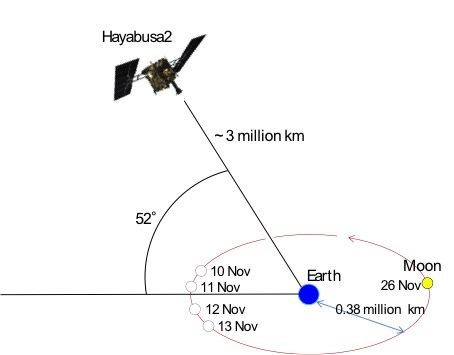The Hayabusa2 asteroid explorer has taken a snapshot of the Earth and Moon as it approached the Earth to receive a gravitational push towards asteroid Ryugu. This planned swing-by is known as a 'gravity assist'; a manoeuvre that uses the Earth's mass to turn Hayabusa2's trajectory towards asteroid Ryugu. The image was taken on the November 26, 2015 at 2:34 UT (11:34 JST) with the onboard TIR (Thermal Infrared Imager) camera.
The image was taken at a distance of 3 million kilometres from the Earth, with the Sun-Earth-Spacecraft angle at 52° north from the ecliptic plane. Comparing the new image to those taken on the 10 to 13 November, you can see the Earth and Moon now appear bigger, brighter and further apart, with the Moon now on the opposite side of the Earth.
The TIR camera is the thermal imaging camera which images the thermal (heat) emission from bodies at 10 micrometre wavelengths. The TIR has been developed and is operated by the Japan Aerospace Exploration Agency (JAXA), Hokkaido University, Rikkyo University, Chiba Institute of Technology, University of Aizu, Hokkaido University of Education, National Institute of Advanced Industrial Science and Technology (AIST), National Institute for Environmental Studies (NIES), National Institute of Information and Communications Technology (NICT), University of Tokyo, Graduate University for Advanced Studies (SOKENDAI), German Aerospace Center (DLR), Max-Planck Institute for Extraterrestrial Physics (MPE), The Open University, UK.
-
 On November 26, 2015, the Earth (white spot, centre) and the Moon (small white spot, right) imaged by TIR. The positions of Hayabusa2, Earth, and Moon are shown as below. (©JAXA).
On November 26, 2015, the Earth (white spot, centre) and the Moon (small white spot, right) imaged by TIR. The positions of Hayabusa2, Earth, and Moon are shown as below. (©JAXA).
-
 Positions of Hayabusa2, Earth and the Moon (©JAXA)
Positions of Hayabusa2, Earth and the Moon (©JAXA)

